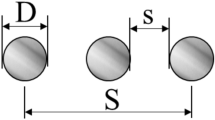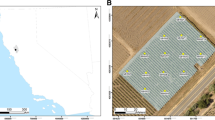Abstract
Despite subtle variations in soil moisture (SM) across a paddock, irrigation scheduling in New Zealand dairy farms is solely based on the SM monitored at a single location, primarily using an Aquaflex soil moisture sensor at a specified root depth. This study aimed to address this issue by assessing the “effective” root depth of a pasture, calibrating the Aquaflex soil moisture sensor and evaluating the spatial and temporal variability of SM. Twenty non-weighing lysimeters and 1 Aquaflex with 2 sensors installed 125-m away from the lysimeters on the same paddock were utilized for the study. TDR probes with 200-, 500- and 900-mm lengths were installed vertically adjacent to the Aquaflex and the lysimeters for monitoring spatio-temporal variability in SM, and calibrating the Aquaflex. A dry down experiment was performed for investigating the root depth of the pasture. All TDR probes responded to wetting and drying events, with varying SM measurements both vertically and horizontally, due to variations in soil type at different locations, indicating a need of SM monitoring at different locations in the paddock for irrigation scheduling. There was a strong linear relationship between the Aquaflex and TDR probes readings, which can be used to calibrate the Aquflex and improve its reliability for measuring soil moisture and in turn irrigation needs. Over the dry down period, out of the total moisture change in the 0–900-mm soil profile, 96% was contributed by 0–500 mm, indicating that the significant root depth of the pasture lies on the top 500-mm soil profile. Findings of the study can contribute to better irrigation scheduling and to conserve water.







Similar content being viewed by others
Notes
The dielectric constant is the capacity of a non-conducting material to transmit electromagnetic waves or pulses (Charlesworth 2005).
References
Allen RG, Pereira LS, Howell TA, Jensen ME (2011) Evapotranspiration information reporting: I. Factors governing measurement accuracy. Agric Water Manag 98(6):899–920
Anthony P, KC B (2017) Improving irrigation water management using agent technology. New Zeal J Agric Res 6(4):425–439
Barringer JR, Lilburne L, Carrick S, Webb T, Snow V (2016) What difference does detailed soil mapping information make? A Canterbury case study. In: Integrated Nutrient and Water Management for Sustainable Farming, Occasional Report. Fertilizer and Lime Research Centre, Massey University, Palmerston North, New Zealand.
Blonquist JM Jr, Jones SB, Robinson D (2005) A time domain transmission sensor with TDR performance characteristics. J Hydrol 314(1):235–245
Cameron KC, Smith NP, McLay C, Fraser PM, McPherson R, Harrison D, Harbottle P (1992) Lysimeters without edge flow: an improved design and sampling procedure. Soil Sci Soc Am J 56(5):1625–1628
Cape J (1997) Development of value selection method for choosing between alternative soil moisture sensors. In: Land and Water Resources Research and Development Corporation Project No. AIT2, Canberra, Austraila.
Chandler D, Seyfried M, Murdock M, McNamara J (2004) Field calibration of water content reflectometers. Soil Sci Soc Am J 68(5):1501–1507
Charlesworth P (2005) Soil water monitoring an information package. In: 2nd edition, land and water australia on behalf of the national program for sustainable irrigation, Canberra, Australia. Retrieved from http://www.publish.csiro.au/book/5079/
Duncan M, Srinivasan M, McMillan H (2016) Field measurement of groundwater recharge under irrigation in Canterbury, New Zealand, using drainage lysimeters. Agric Water Manag 166:17–32
Evett S (2016) Soil water sensors for agriculture—theory and issues, NRCS soil water sensor webinar seminar series. In: United State Department of Agriculture, Agricultural Research Service, Texas, USA.
George BA, Shende SA, Raghuwanshi NS (2000) Development and testing of an irrigation scheduling model. Agric Water Manag 46(2):121–136
Hedley CB, Yule IJ (2009a) A method for spatial prediction of daily soil water status for precise irrigation scheduling. Agric Water Manag 96(12):1737–1745
Hedley CB, Yule IJ (2009b) Soil water status mapping and two variable-rate irrigation scenarios. J Precis Agric 10(4):342–355
Hedley C, Bradbury S, Ekanayake J, Yule I, Carrick S (2010) Spatial irrigation scheduling for variable rate irrigationNew Zealand Grassland Association. Symp Cond Meet Proc New Zeal Grassl Assoc 72:97–102
Jacobs JM, Mohanty BP, Hsu EC, Miller D (2004) SMEX02: field scale variability, time stability and similarity of soil moisture. Remote Sens Environ 92(4):436–446
Jones SB, Wraith JM, Or D (2002) Time domain reflectometry measurement principles and applications. Hydrol Process 16(1):141–153
KC B (2008) Improvement in land and water productivity of the irrigated area in emerging and least developed countries for food security. Master thesis, UNESCO-IHE Institute for Water Education, Delft, The Netherlands.
KC B (2016) Irrigation scheduling: a soft adaptor to weather uncertainties and irrigation efficiency improvement initiatives. PhD thesis, Lincoln University, Christchurch, New Zealand.
KC B, Schultz B, Prasad K (2011) Water management to meet present and future food demand. Irrig Drain 60(3):348–359
KC B, Breneger S, Curtis A (2016) Soil moisture monitoring. Book 11. Irrigation New Zealand, Christchurch, New Zealand, Retrived from https://www.irrigationnz.co.nz/Members%20Only/good%20management%20practice/Book11-SoilMM.pdf
KC B, Schultz B, Prasad K (2017) Impact of irrigation management practices on land and its productivity in addressing hunger and poverty. J Dev Innov 1(2):15–28
KC B, McIndoe I, Rutter H, Dark A, Schultz B, Prasad K, Suman S, Paudel K (2018a) Impacts of dairy farming systems on water quantity and quality in Brazil, Ethiopia, Nepal, New Zealand and USA. In: Presented at 8th Asian Regional Conference, held from 2–4 May 2018, Kathmandu, Nepal.
KC B, Mohssen M, Wai CH, Curtis A, Cuenca R, Bright J, Srinivasan MS, Cameron K (2018b) Impact of rotational grazing systems on the pasture crop coefficient for irrigation scheduling. Irrigat Drain 67(3):441–453
KC B, Mohssen M, Wai CH, Curtis A, Cuenca R, Bright J, Srinivasan MS, Safa M (2018c) Irrigation strategies for rotational grazing pasture in canterbury, New Zealand, and impacts on irrigation efficiency. Irrigat Drain 67(5):779–789
KC B, Wai CH, Mohssen M, Cameron K, Safa M, McIndoe I, Rutter H, Lee M, Pandey VP, Schultz B, Prasad K (2019) An improved approach for estimating soil moisture content to improve irrigation decisions. In: Presented at 3rd World Irrigation Forum, held from 1–7 September 2019, Bali, Indonesia.
Lee JM, Donaghy DJ, Sathish P, Roche JR (2010) Perennial ryegrass regrowth after defoliation—physiological and molecular changes. Proc N Zeal Grassl Assoc Lincoln N Zeal 72:127–134
Miyamoto T, Kobayashi R, Annaka T, Chikushi J (2001) Applicability of multiple length TDR probes to measure water distributions in an Andisol under different tillage systems in Japan. Soil till Res 60(1):91–99
Monaghan RM, De Klein CAM, Muirhead RW (2008) Prioritisation of farm scale remediation efforts for reducing losses of nutrients and faecal indicator organisms to waterways: a case study of New Zealand dairy farming. J Environ Manage 87(4):609–622
National Institute of Water and Atmospheric (NIWA) (2015) The National Climate Database, Christchurch, New Zealand. Retrievedfrom https://cliflo.niwa.co.nz/. Accessed 23 July 2015
Paige GB, Keefer TO (2008) Comparison of field performance of multiple soil moisture sensors in a semi-arid Rangeland1. JAWRA J Am Water Resour Assoc 44(1):121–135
Parry FJ (1994) Productivity and water use of seven pasture grasses when sown alone and in binary mixtures. MSc thesis, Lincoln University, Christchurch, New Zealand.
Plauborg F, Iversen BV, Lærke PE (2005) In situ comparison of three dielectric soil moisture sensors in drip irrigated sandy soils. Vadose Zone J 4(4):1037–1047
Robinson D, Jones SB, Wraith J, Or D, Friedman S (2003) A review of advances in dielectric and electrical conductivity measurement in soils using time domain reflectometry. Vadose Zone J 2(4):444–475
Schultz B, Zimmer D, Hofwegen PV (2007) Agriculture food water: concept note in preparation for 5th World Water Forum, Marseille, France.
Schultz B, Tardieu H, Vidal A (2009) Role of water management for global food production and poverty alleviation. Irrig Drain 58(S1):S3–S21
Seyfried M, Murdock M (2001) Response of a new soil water sensor to variable soil, water content, and temperature. Soil Sci Soc Am J 65(1):28–34
Skierucha W, Wilczek A, Szypłowska A, Sławiński C, Lamorski K (2012) A TDR-based soil moisture monitoring system with simultaneous measurement of soil temperature and electrical conductivity. Sensors 12(10):13545–13566
Srinivasan M, Duncan M (2011) Supply, restriction and water use: a survey at the Waimakariti irrigation scheme. In: Presented at 24th Annual Fertilizer and Lame Research Centre (FLRC) Workshop, Massey University, New Zealand.
Topp G, Zebchuk W, Davis J, Bailey W (1984) The measurement of soil water content using a portable TDR hand probe. Can J Soil Sci 64(3):313–321
Tromp-van Meerveld H, McDonnell J (2006) On the interrelations between topography, soil depth, soil moisture, transpiration rates and species distribution at the hillslope scale. Adv Water Resour 29(2):293–310
Van Housen J (2015) Modelling the Temporal and Spatial Variation of Evapotranspiration from Irrigated Pastures in Canterbury. PhD thesis, Lincoln University, Christchurch, New Zealand.
Whenua M (2019) S-map—New Zealand’s national digital soil map. Lincoln, Landcare Research
Woodward S, Barker D, Zyskowski R (2001) A practical model for predicting soil water deficit in New Zealand pastures. N Z J Agric Res 44(1):91–109
Young M, Mancino C, Wierenga P (2000) Time domain reflectometry: measuring soil water content. Golf Course Manag 68(2000):66–70
Acknowledgements
Our thanks go to South Island Dairying Development Centre (SIDDC) for allowing access to conduct experiments on Lincoln University Dairy Farm (LUDF) and utilize their equipment. We are also very grateful for the assistance provided by Ron Pellow (Executive Director LUDF), Peter Hancox (Manager, LUDF), Trevor Hendry (Technician at the soil department) and Warwick Hill (Technician at the department of environmental management) for assistance in the field. The authors also would like to acknowledge funding sources provided by Lincoln University to support this study.
Author information
Authors and Affiliations
Corresponding author
Ethics declarations
Conflict of interest
The authors declare that they have no competing interests.
Additional information
Communicated by Leonor Rodríguez-Sinobas.
Publisher's Note
Springer Nature remains neutral with regard to jurisdictional claims in published maps and institutional affiliations.
Rights and permissions
About this article
Cite this article
KC, B., Chau, H.W., Mohssen, M. et al. Assessment of spatial and temporal variability in soil moisture using multi-length TDR probes to calibrate Aquaflex sensors. Irrig Sci 39, 703–713 (2021). https://doi.org/10.1007/s00271-021-00747-x
Received:
Accepted:
Published:
Issue Date:
DOI: https://doi.org/10.1007/s00271-021-00747-x




